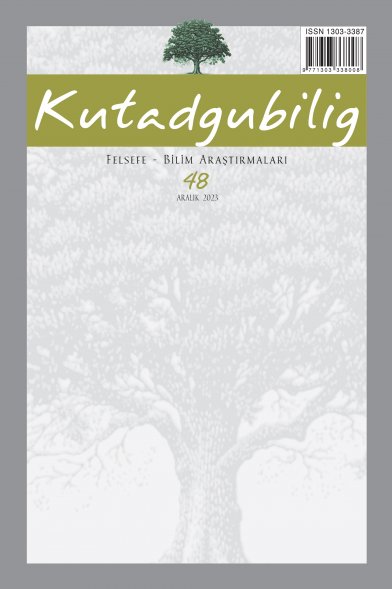Klasik Fizikten Kalan Metafizik Miras: Heisenberg Belirsizlik İlkesi
20. yüzyılın başlarından itibaren fizikte yaşanan iki 'sıçrama'; izafiyet ve kuantum teorileri Çağdaş Doğa Felsefesi'nin doğmasına yol açmıştır. Kuantum Teorisinin kurucularından Alman fizikçi-filozof Werner Heisenberg tarafından 1927 yılında formüle edilen belirsizlik ilkesi, sadece yeni bilimin istikametini belirleyen fiziksel bir özellik değil, aynı zamanda çağdaş doğa düşüncesini metafizikle buluşturan, bilimsel bilgi ile felsefî ve dinî alanlara ilişkin diğer bilme türlerinin ve insanî tecrübelerin karşılaştırılmasına imkan veren bir köprü işlevi görmüştür. Bu çalışmada klasik fizikten kalan metafizik bir miras olarak nitelendirdiğimiz 'belirsizlik ilkesi'nin çağdaş doğa düşüncesini derinden etkileyen felsefî sonuçları üzerinde durulacaktır.
Metaphysical Inheritance of Classical: Heisenberg Uncertainty Principle
The two big 'jumps' in physics since the beginning of the 20th century; the theory of relativity and the quantum theory, have led to the establishment of the modern philosophy of nature. The uncertainty principle, formulated by the German physicist and philosopher Werner Heisenberg, who was one of the founders of the quantum theory, is not only a physical peculiarity. This principle also combines the thought of contemporary nature with metaphysics and by putting up a bridge between them, paves the way for a comparison between the scientific knowledge, other types of knowing in the areas of philosophy and religion and experiences of mankind. This work lays stress on the philosophical effects of the 'uncertainty principle', which we characterize as a metaphysical inheritance of classical physics. These effects have deeply influenced the contemporary idea of nature.
___
Barbour, G. Ian, Issues in Science and Religion, Harper Torchbooks, New York&London 1966.Bohm, David, Wholeness and the Implicate Order, Routledge & Kegan Paul, London, Boston 1980.Barnett, Lincoln, Einstein ve Evren, Işık kitapları, Istanbul 1959.
Bohr, Niels Atomic Physics and the Description of Nature, Cambridge: Cambridge University Press, 1934.
Capra, Fritjof, Yeni Bir Düşünce, Ağaç yayıncılık, Çev:Mustafa Armağan, İstanbul 1992.
Collingwood, R.G. The idea of nature, New York: Oxford University Press, I960. Doğa Tasarımı, Çev.: Kurtuluş Dinçer, İmge Yayınları, İstanbul 1999.
Comte, Aguste, Pozitif Felsefe Kursları, Sosyal Yayınlan, İstanbul 2001.
D'Abro, A., The Rise Of New Physics, Dover Publications; 2d edition 1952.
De Broglie, Louis, Yeni Fizik ve Kuvantumlar, Kabala yayınevi, Çev: Yakup Sahana, İstanbul 1992.
Gleick, James, Chaos; Meaning a New Science, N.Y Viking Press, Türkçesi: Kaos, Tübitak Yayınları, Ankara 2000.
Heisenberg, Werner, Einsteinle Yüzleşmek, Çev: Kemal Budak, Gelenek Yay. İstanbul 2003
Heisenberg, Werner, Across The Frontiers, Translated from the German by Peter Heath, Harper-Row Publishers, New York, London 1974.
Heisenberg, Werner, Physics and Philosophy, Türkçesi: Fizik ve Felsefe, Çev: Necibe Çakıroğlu, İTÜ yay.İstanbul 1972.
Heisenberg, Werner,} Çağdaş Fizikte Doğa, V yayınları, Ankara 1987.
Heisenberg, Werner, Parça ve Bütün, Çev: Aşye Atalay, Düzlem Yayınları, İstanbul 1990.
Heisenberg, Werner, Physics And Beyond, Encounters And Conversations, Harper&Ro Publishers, Newyork, London 1971.
Horgan, John. Bilimin Sonu, Gelenek Yayınları, İstanbul 2003.
Kocabaş, Şakir. Fizik ve Gerçeklik, Küre Yayınları, İstanbul 2001.
Koç, Yalçın, Doğanın Kuvantum Mekaniksel Betimlemesi ve Ölçme Sorunu, Doktora Tezi, 1978.
Planck, Max, Modem Doğa Anlayışı ve Kuantum Teorisine Giriş, Spartaküs Yay. İstanbul 1996.
Penrose, Roger, Büyük, Küçük ve İnsan Zihni, Sarmal Yayınları, İstanbul 1998.
Prigogine, Uya, Kesinliklerin Sonu, Sarmal yay. İstanbul 1999.
Smith, Wolgang. Kuantum Bilmecesi, İnsan Yayınları, İstanbul 2000.
Zohar, Danah, Kuantum Benlik, Sarmal yay. Çev: Seda Kervanoğlu, İstanbul 1998.
Zukav, Gary, The Dancing Wu Li Masters, Bantam Books, New York 1980.
- ISSN: 1303-3387
- Yayın Aralığı: Yılda 2 Sayı
- Başlangıç: 2002
- Yayıncı: Dergah Yayınları A.Ş.
Sayıdaki Diğer Makaleler
Franz Brentano'nun Çağdaş Batı Felsefesine Etkileri
Gerçek Dünyanın Kesin Olmayışının Üstesinden Gelmek: Lütfü A. Zadeh ile Bir Röportaj
Aristoteles'te Hoşlanma ve Katharsis Kavramını Ruhbilimsel-Varlıkbilimsel Olarak Yeniden Okuma
Maneviyatın Fenomenolojisi İlk Basılışının İkiyüzüncü Yıldönümü
Düşünce Tarihinde Epistemolojik Bir Denge Unsuru Olarak Ayna Metaforu
Puslu Mantığın Doğuşu ve Evrimi
Klasik Fizikten Kalan Metafizik Miras: Heisenberg Belirsizlik İlkesi
